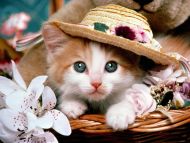The kidneys are an amazing pair of organs! When we think of the kidneys, we think of urine production, but they do much more than make urine. They produce hormones that help control red blood cell production and calcium levels, and they are the gates for recycling nutrients using a sophisticated filtering system. They also play a very important role in conserving water, and assist with the control of blood volume and concentration!
Now you are wowed, let us talk about what happens when they don’t work properly anymore. Once again, you would be amazed to hear that the kidneys are able to do their job up for your kitty up to the point where 75-80% of their tissue is damaged. The body can compensate for significant loss of functional filtration units (nephrons) by engaging the remaining functioning ones left in the kidneys to do extra work. These nephrons working overtime do eventually get exhausted though, and when this occurs, the kidney dysfunction moves from a compensated disease to true kidney failure!
At this point, obvious signs that the system is failing occur. Toxins build up in the blood stream, and lead to generalized malaise. Urine volume will become greater, cats may become very thirsty, and the urine is more dilute (color changes from dark yellow, to pale yellow to clear). Kitty may even have accidents in the house! The appetite drops, ulcers may occur in the mouth and cats may drool, the body condition becomes thin and wasted, and kitty gets progressively weaker. Sometimes the head even droops and cannot be raised if a specific blood electrolyte (potassium) is low. Vomiting is a frequent sign, and some cats (when they develop more advanced problems) may become so weak they cannot get around. Dehydration will set in, anemia will occur, and kitty will become critically ill. Organ failure is much more common in senior and advanced geriatric aged cats, with an average age of onset at nine years old.
There is no cure for chronic kidney failure. Catching kidney problems while in the early phases allows us to start therapy to help slow the progression of the disease and to improve the quality of life. Sometimes X-rays and ultrasound will show shrunken rough kidneys, and sometimes the kidneys will swell up. Blood pressure may be elevated.
In the early phases, while the kidneys are still able to compensate, special diets may help to take the load off of the failing kidney, and supplements and medication may be started at this point also. Once the cat is in full failure, the veterinarian will admit Kitty to the hospital for a period to provide intensive care. Intravenous fluids are the mainstay of therapy. The goal is to “flush” the toxins out of the bloodstream. Drugs to encourage the appetite and reduce vomiting may be administered, and the specific correction of imbalances (potassium replacement, phosphate binders) will be carried out.
If the cat can be stabilized during the crisis, she may get along for months, or sometimes, even a few years with continued supportive therapy. Regular monitoring is essential. Performing annual wellness monitoring of senior cats provides an excellent opportunity to identify cats in the early phase of organ dysfunction, so you and the veterinary health care team get working on preventive therapy before the crisis hits!
See Client Procedures: Administering Subcutaneous Fluids if you wish to learn more about how chronic kidney failure cats benefit from home fluid administration.



Tidak ada komentar:
Posting Komentar